By Marketing
30.05.2019
In the beginning, there was just a word.
„The biggest advertising campaign in human history was launched by Jesus Christ, with the universal slogan »Love Your Neighbor«. And it had a remarkable logo: The Cross.“
Oliviero Toscani
The Bible is still one of the most widely used narrative works ever written and serves as one of the most comprehensive examples of visual writing. But already at the beginning of the first high cultures and free trade, the loud market barker has developed into a writer, whereby the first sales-promoting means of the form of word and font were used. Enterprises emerged, markets competed, and both diversification and information became very important for successful trading. Whether Egyptian hieroglyphs, Asian logographs or primitive cave paintings. They all precede the development of our communication as we know it today. Especially the industrial revolution of the 19th century contributed significantly to the emergence of the so-called advertising text, as mass production increased and created, at that time, the first newspaper publishers with a new media. The economic sector of advertising agencies was born. And so on the advertisement with screen printing, 1846, became a global classic. - The billboard. Finally, at the end of the century, TV and radio also followed, all the way to the digital revolution, which reaches us with around 6,000 MobileAds – each day.
Copies everywhere.
If you know what to look for. It’s all about details again - and we can never show you enough of that at PIXIT. The medium is primarily crucial and, far more, creates the tone. Because most MobileAds and advertisers aim for recognition in the in and out of home area, the headlines and short copies are of central importance. If information and entertainment are in the focus of the advertiser, then the professional field deepens in the direction of conception and campaign-planning. But both include the basics of a copywriter’s job. It’s areas of activity include:
Headlines & Slogans
These can be found both in the creative and in the economic sector. Headlines are mainly used for striking advertising impact, while the slogan communicates, for example, a company’s motto.
Short- & Long-Copies
Varied brand stories and informative product insights are mainly created by copywriters in advertising agencies, as they convey a specific mission statement. In turn, press releases, public relations and magazines are created by the journalistic experts.
TV- & Online-Spot
The 20-seconds-spot is the undefeated advertising medium to tell stories. However, these can vary in length and structure depending on the campaign’s goal. The copywriter creates the idea, writes the script, describes the visuals and the audio accompaniment.
Radio advertising
Contrary to expectations, the radio is still in great demand today, when short information and supporting advertising impact are in the focus. The copywriter writes a script, similar to the visual spot. This includes the spoken text as well as information about the sound.
Copies on the web
In the age of SEO and SEA, optimized web texts are the embellished advertising medium for websites and social media. Hereby, headlines, short- and long-copies move close together. - Followed by keywords and tags, they are representatives for businesses on the web.
A copywriter plays a leading role in the creative economy, because unlike the usual writer, he grabs a basic idea and turns it into various communication channels and, in the case of a subject or spot, conceives both the text and the plot. The big idea that precedes the concept is ideally determined by the client, consultant and copywriter/conceptioner.
No matter what you think, think the opposite!
Ogilvy & Mather should know it best. 500 successful agencies in 125 countries are already a powerful argument anyway. But what makes them so successful - the copies of the world? First you need to understand how a copy works.
„The consumer is not just some idiot, but your wife.“
David Ogilvy
After all, you do not write for a crowd and the whole world - you write for just one person. A person who - like yourself - is driven by emotions, habits and is confronted with a variety of situations every day. You have to understand him and tie him with your words, make him part of your vision. Excite and surprise him. For example, in a marketing text from Volvo you do not write about the components and the mechanics, but about the power, your irrepressible freedom. You can experience the comfort and feel the safety, first hand.

Just do it.
If you look for attention, you should not think too long and just start writing. You do not need athletic ambitions to reach that goal. The greatest achievements of the history of advertising came from intuition, spontaneity and the most important element - childishness. Because children are not afraid to think wrong. For a child, everything is possible. You will learn about limits only later in life. Likewise, from a physical point of view, it is impossible for a bumblebee to fly - yet it flies. And why? Because it does not know it can’t fly. And that's exactly what creative writing in advertising is all about. - There are no limits to your imagination.
Think different.
With its slogan, Peter Economides, TBWA Los Angeles, rethought the world in 1997 and put Apple on the podium, which we should listen to for a long time by now. A copy that catches all of us. It makes us feel understood and makes us part of something bigger. Create trust and connect us with the brand. As a pioneer of digitization, the innovative tech giant represents the symbol of "new thinking" and has already recognized the mechanism of creative wording for its image in its early years - thinking of the commercial, from the year 1984. A true masterpiece, which is still one of the most well-known brand messages and can be found in any promotional bible: „On January 24th, Apple Computer will introduce Macintosh. And you'll see why 1984 won't be like 1984."
What makes these copies so successful? - They encourage thinking. Embody the feeling of innovation and self-confidence, - and show the complexity in its own simplicity.
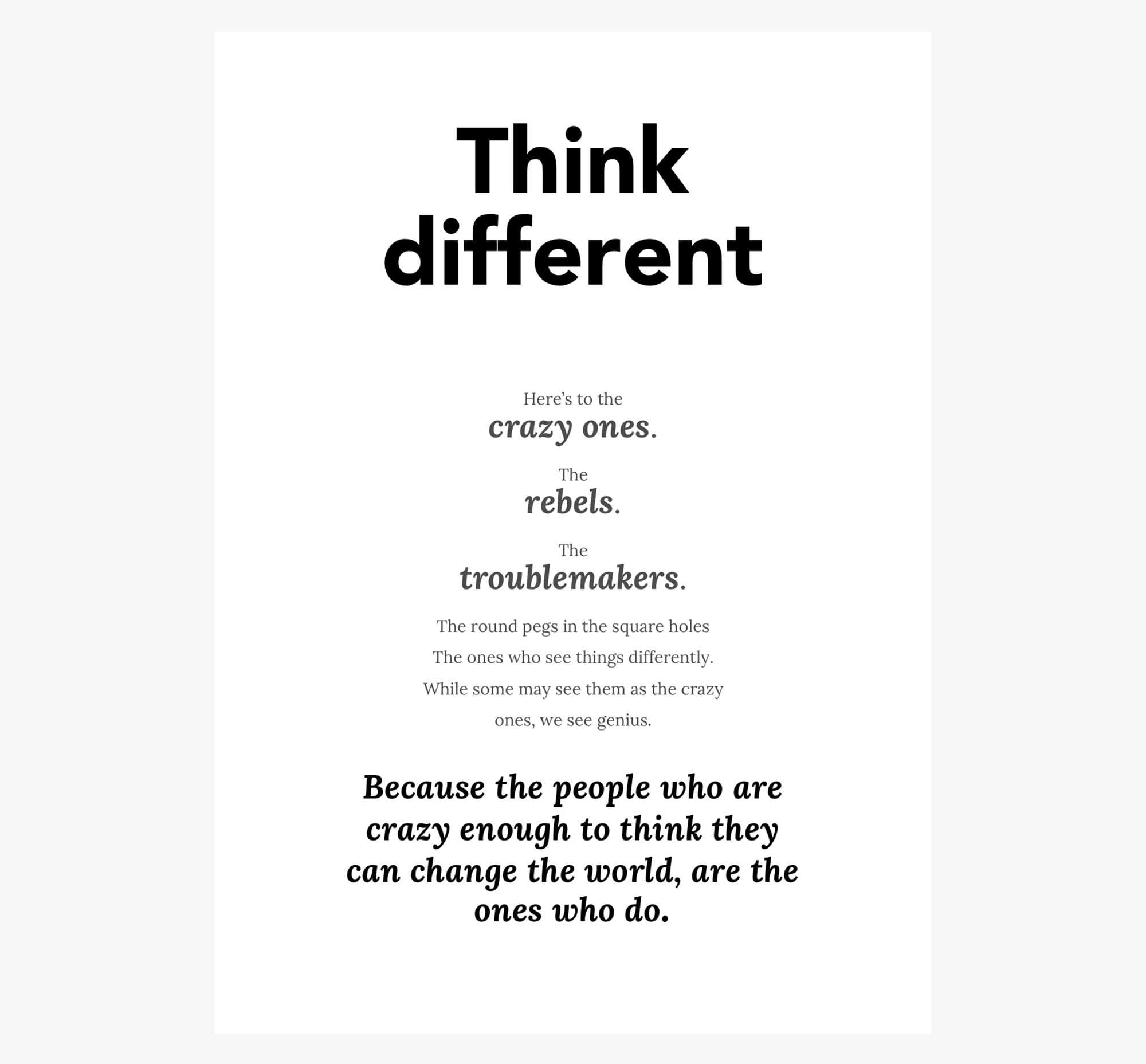
Apple – Think different
FCK
How to play with strong words and keep hungry customers happy is also shown by KFC - in its business statement.
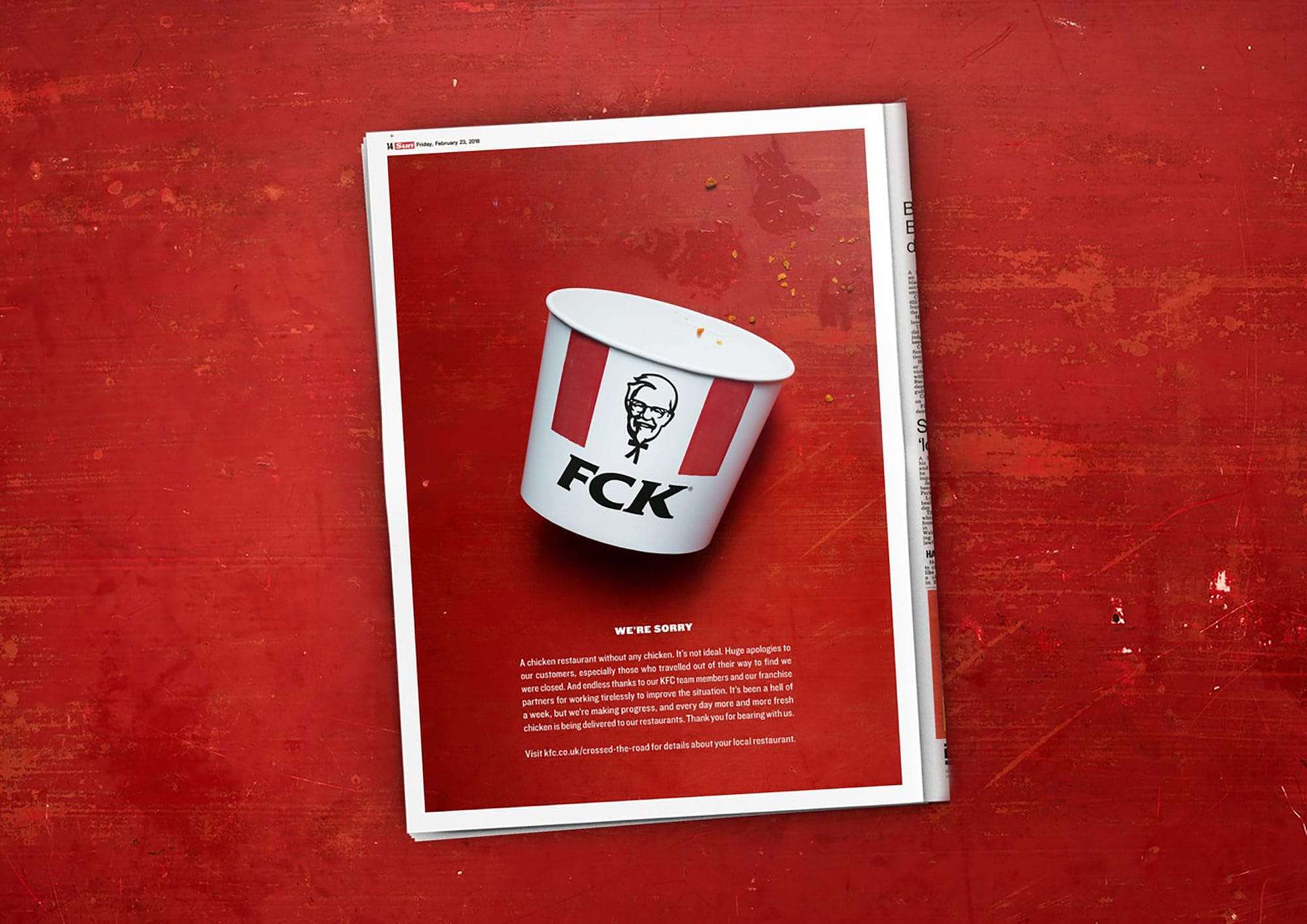
KFC
Be scandalous and break the rules!
For Benetton, many of us think of dark-skinned children in colorful sweaters with Asian parents and cultural commitments. Oliverio Toscani, 1983, went one step further with his campaign for the well-known fashion company. On one hand it was a bitter pill for their brand manager – on the other hand a model example of brand impact and global controversy. This concept is also followed by the film 39.90 (99 francs), with a parody par excellence.
„Kein verantwortungsloser Idiot hatte in den letzten 2.000 Jahren jemals so viel Macht wie ich.“
Octave Parango
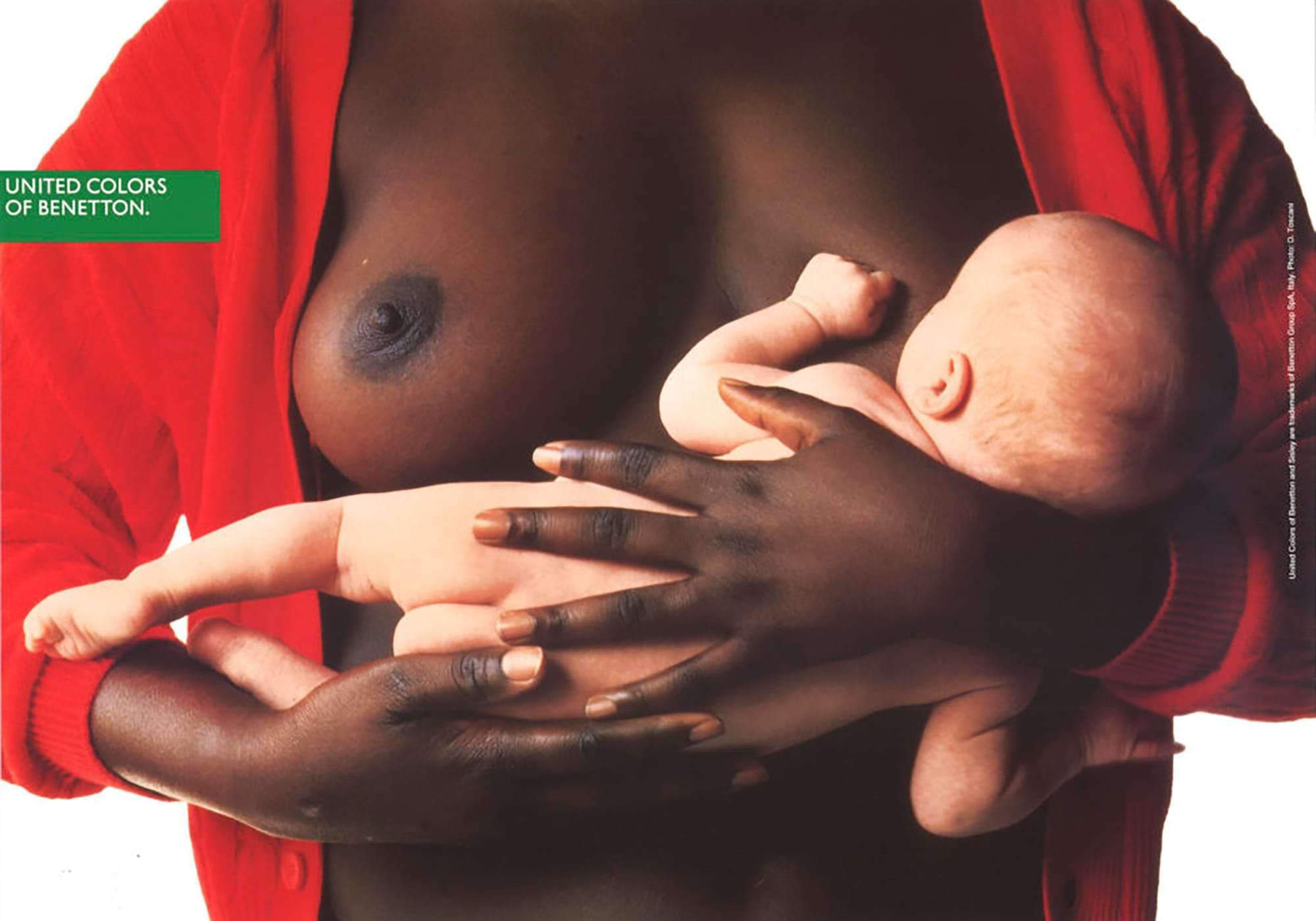
UNITED COLORS OF BENETTON
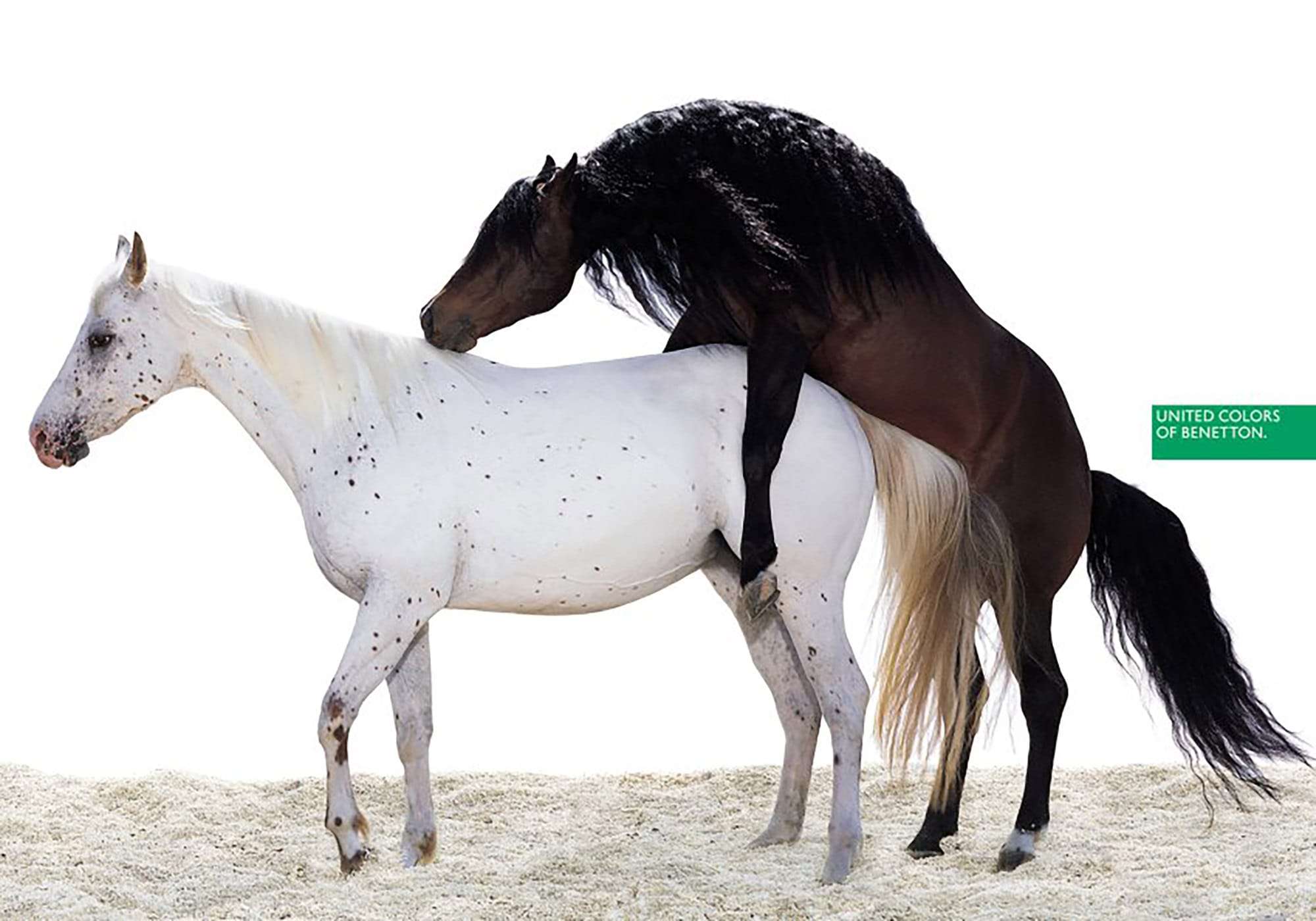
UNITED COLORS OF BENETTON
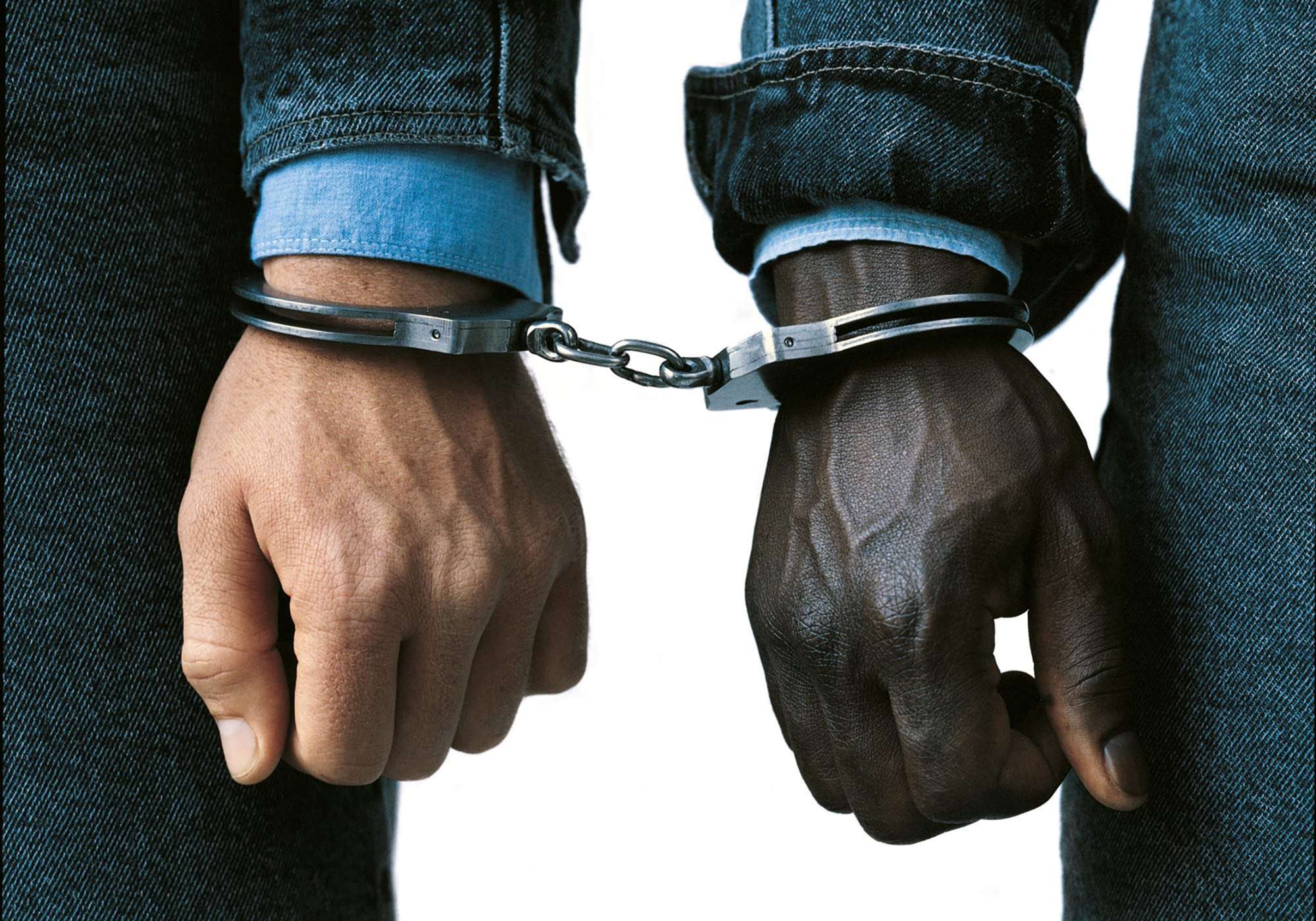
UNITED COLORS OF BENETTON
Word Wide Web.
„SEO is a marketing function for sure, but it needs to be baked into a product, not slapped on like icing after the cake is baked.“
Duane Forrester
We share our posts with the whole world. At the same time, we have barely understood how relevant professional texts are for the success of a website and how this affects your followers.
On an average website, the user is welcomed by a flat headline at the beginning, followed by quality promises and 0815 advertising phrases. How to build personal trust in a company, if it has no personality? Authentic communication is evidence of quality and understanding. Stability and value. But not only for us humans. Above all, Google also crawls our websites on relevant context and classifies it accordingly. The top 5 search results achieve around 75% of total clicks. Ranking is not a trend, but a must-have. In fact, it is advisable to consider website texts already when creating the website and to write SEO-compliant. That saves time and money. Subsequent text adjustments and optimizations are complex but still necessary to guarantee the best possible ranking. SEA, the search engine advertising, belongs to online marketing too and is an essential tool to gain your reach and target groups, without large stray losses. As one of the most popular leisure activities, social media is one of the most attractive advertising channels with 3.2 billion daily accesses. With 68% of user time, Facebook remains market leader and provides a low-cost alternative to our traditional media. Of course - if the text fits. In order for authentic postings and contributions to be published, the wording must be harmonized with each other and integrated into the imagery, as on the website. After all, online communication is the first contact with your potential customers. It often decides "like", optimized interaction and positive reviews.
Tips and techniques
Osborn checklist
The optimization of a product promises the actual success. To identify these characteristics, it needs to go through a series of changes. This technique can be used in groups, but also individually.
- Adaptation: Parallels to similar products? What could you take over?
- Modification: Change the feel, color, movement, shape, sound, smell, etc.?
- Magnification: Add details, exaggerate, distances, length, thickness, or enlarge the product?
- Reduction: What can be omitted? Zoom out, brighter, thinner, lighter.
- Substitution: What is replaceable? Use of other materials, new processes.
- Regrouping: Which parts can be swapped or changed in sequence?
- Reversal: What is the topic on the contrary?
- Combination: What can be combined? Can you disassemble it into parts?
- Transformation: How can you change or deform it?
6-3-5
Six participants create three ideas by themselves, which are developed five times. This technique can also be effectively adapted to smaller teams.
- Step 1: The 6 participants receive a worksheet on which the question of the marketing goal as well as free fields for the ideas can be found. 6 rows of 3 columns each.
- Step 2: Set the time to pass the worksheets. Usually between 3-5 minutes.
- Step 3: Each participant enters 3 ideas in the empty columns of the first line.
- Step 4: When the time has expired, the worksheet is handed over in a clockwise direction.
- Step 5: Each participant will receive 3 ideas with the copy of the worksheet, which he should now further develop and supplement. So now there are 3 modified ideas, which are now entered in the next free line.
- Step 6: Passing on until all fields are filled.
Flip-Flop
The headstand. The problem is presented with a question. Now the question is completely reversed – into the exact opposite - and given two extreme solutions.
- Step 1: The task is formulated as a question and then presented in the opposite direction.
- Step 2: The participants express their ideas in key words, by e.g. a senior moderator or a brainstorm pool.
- Step 3: As a rule, the evaluation yields two approaches. The actual situation that should be changed and the other, target situation that is sought. The target situation is reached by renewed reversal of the actual situation.
- Step 4: The participants are now committed to the right strategy.
What else?
Take a quick coffee break and collect your thoughts on how to build your next copy. Please note the most important facts for your writing:
- Note the jargon of your target audience. - Capiche?
- Use terms in your copies that you understand and do not have to look up. Unless you promote the Duden.
- Face the rules in countries where your ad is published. And break them - sometimes.
- Get to know the product or the topic. And its main features.
- Use creative techniques to change your perspective.
- Take your first ideas and develop them further.
- SHOCK!
- Forget what is possible and what is not. Think like a child.
- Your headline already tells half of the story.
- Inform yourself about the advertisements or copies of the competition.
- Stay true to your style, but keep in mind the client's corporate wording.
- Put the topic in confrontation with the actual benefit.
In the end, writing also needs sensitivity, a certain talent and a tendency to break taboos. So if you continue typing without meaningfully writing anything, we’d like to offer our skills, which you can request at office@pixit.design.
Cheerio!